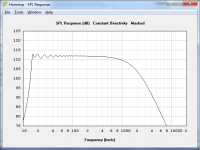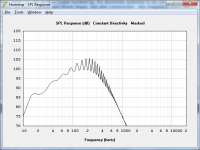Just when I think I have it all straight in my head I find I still don’t have it quite right. I have been trying to work out the difference between front loaded, back loaded and tapped horn.
Trying to search images to get examples, I find I am now more confused than when I started. Can anyone explain in plain English i.e. non-technical terms the difference between them all?
I think that a back loaded horn is where the back of the driver feeds the horn section of the cabinet. I think that front loaded horn is where the front of the driver feeds directly into the horn section and the back of the driver is closed off. Tapped horn I am not sure what it is classified as since both the front and the back of the driver is feed into the horn.
Can anyone please provide clear examples of each. Then if possible a very quick summary of advantages and disadvantages of each.
Edit:
Also need to know what horn loaded is... I think this is the same as front loaded.
Trying to search images to get examples, I find I am now more confused than when I started. Can anyone explain in plain English i.e. non-technical terms the difference between them all?
I think that a back loaded horn is where the back of the driver feeds the horn section of the cabinet. I think that front loaded horn is where the front of the driver feeds directly into the horn section and the back of the driver is closed off. Tapped horn I am not sure what it is classified as since both the front and the back of the driver is feed into the horn.
Can anyone please provide clear examples of each. Then if possible a very quick summary of advantages and disadvantages of each.
Edit:
Also need to know what horn loaded is... I think this is the same as front loaded.
Last edited:
Found some info in a post which most people seem to agree with...
"Front load = you hear mostly speaker tone. Very little cab coloration.
Rear load = a good one will give you that deep, warm woody 'knock' whilst still being tight and percussive."
Not sure in for a sub which is more desirable though.
"Front load = you hear mostly speaker tone. Very little cab coloration.
Rear load = a good one will give you that deep, warm woody 'knock' whilst still being tight and percussive."
Not sure in for a sub which is more desirable though.
3 pics of front loaded horns:
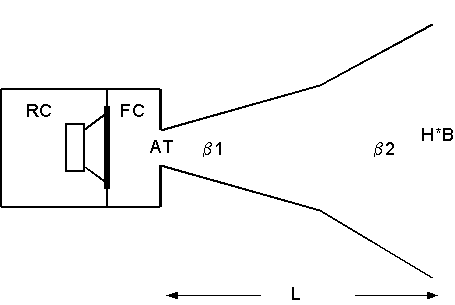

3 pics of rear loaded horns: (the third example in the 3rd pic is a front/rear hybrid)
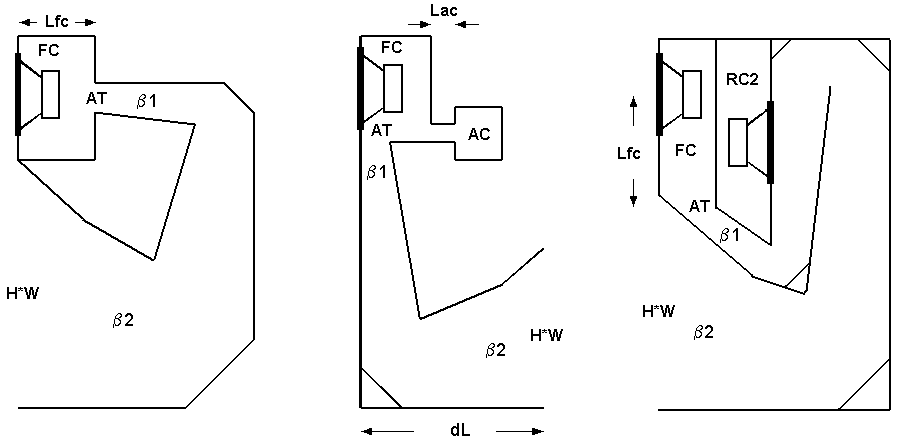
3 pics of tapped horns:

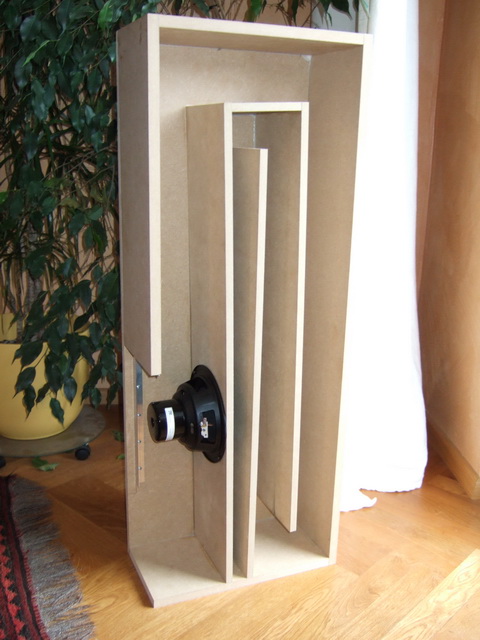

All courtesy of a quick google search.
Front loaded horns have a rear sealed chamber for the driver, while rear loaded horns do not. Tapped horns are rear loaded horns with a clever driver position that eliminates a null common to rear loaded horns.
Horn loaded refers to the horn flare itself. All types of horn (front, rear and tapped) are horn loaded.
This is why I was saying there is no need for detailed Hornresp instructions (beyond what's already there). You have to understand the basics first, otherwise no amount of Hornresp instructions is going to help.
An externally hosted image should be here but it was not working when we last tested it.

3 pics of rear loaded horns: (the third example in the 3rd pic is a front/rear hybrid)
An externally hosted image should be here but it was not working when we last tested it.
An externally hosted image should be here but it was not working when we last tested it.
3 pics of tapped horns:



All courtesy of a quick google search.
Front loaded horns have a rear sealed chamber for the driver, while rear loaded horns do not. Tapped horns are rear loaded horns with a clever driver position that eliminates a null common to rear loaded horns.
Also need to know what horn loaded is... I think this is the same as front loaded.
Horn loaded refers to the horn flare itself. All types of horn (front, rear and tapped) are horn loaded.
This is why I was saying there is no need for detailed Hornresp instructions (beyond what's already there). You have to understand the basics first, otherwise no amount of Hornresp instructions is going to help.
Last edited:
Found some info in a post which most people seem to agree with...
"Front load = you hear mostly speaker tone. Very little cab coloration.
Rear load = a good one will give you that deep, warm woody 'knock' whilst still being tight and percussive."
Not sure in for a sub which is more desirable though.
This is subjective nonsense. There are very good and very bad examples of each type of horn and there are no subjective descriptions that fit all examples of any particular alignment.
What is desirable is a design that meets the design goals, not a particular alignment.
I think that a back loaded horn is where the back of the driver feeds the horn section of the cabinet. I think that front loaded horn is where the front of the driver feeds directly into the horn section and the back of the driver is closed off. Tapped horn I am not sure what it is classified as since both the front and the back of the driver is feed into the horn.
You've pretty much got it straight, but it's tough to say what one design sounds like vs. another because there are so many other factors involved.
Tapped horns are actually pretty similar to rear loaded horns (aka scoops), except the tapped horn has the driver in the mouth of the horn. They have response peak, cancellation and phase issues above a certain frequency depending on the path length, meaning they are normally used for a narrow bandwidth.
A normal front loaded sub horn typically has a wider bandwidth and can be better used up into the midbass range.
If you really want to get complicated, start looking into bandpass horns (BPH), and ported horns.
Last edited:
3 pics of front loaded horns:
An externally hosted image should be here but it was not working when we last tested it.
This is a hog scoop, which is a cross between a tapped horn and scoop.
This is a hog scoop, which is a cross between a tapped horn and scoop.
Yeah, I grabbed the wrong pic. I fixed it with a different pic.
How about front and rear loaded horns, like the Tannoy Autograph (that was a fun one to test) or a couple of Lowther designs in my youth? Faster flares on the front for the higher frequencies (thus ill adapted for subwoofers, which this thread is about) and very long, slowly expanding flares from the back…
They deserve a category of their own, even if it's only for the "how the heck do I change this driver/cone when it gets damaged?"
They deserve a category of their own, even if it's only for the "how the heck do I change this driver/cone when it gets damaged?"
As post3 shows
a Front Loaded Horn (FLH) has the horn mounted on the front of the speaker. That speaker may, or may not, have a sealed back chamber.
A back loaded horn must have an open back (i.e. not sealed).
The horn is mounted on the back of the speaker.
The front of the speaker usually provides some acoustic output, but this is not a necessary condition for a BLH.
a Front Loaded Horn (FLH) has the horn mounted on the front of the speaker. That speaker may, or may not, have a sealed back chamber.
A back loaded horn must have an open back (i.e. not sealed).
The horn is mounted on the back of the speaker.
The front of the speaker usually provides some acoustic output, but this is not a necessary condition for a BLH.
Last edited:
Tapped horns are actually pretty similar to rear loaded horns (aka scoops), except the tapped horn has the driver in the mouth of the horn. They have response peak, cancellation and phase issues above a certain frequency depending on the path length, meaning they are normally used for a narrow bandwidth.
It's possible to get 3 octaves out of them but it isn't easy and it will be somewhat lumpy response.
The TH-SPUD and DTS-10 are examples. They need a bit of eq but they will do it.
A normal front loaded sub horn typically has a wider bandwidth and can be better used up into the midbass range (assuming the horn is done right). But they will usually have a notch where the front and rear waves meet.
3 octaves is about the max bandwidth unless it's a straight (unfolded) horn with phase plugs.
Rear loaded horns have the most bandwidth (usually) since the response will be flat as high as the driver can play (assuming the horn is done right and has flat response through the horn loaded region). But rear loaded horns will usually have a null where the front and rear waves meet.
Last edited:
It's possible to get 3 octaves out of them but it isn't easy and it will be somewhat lumpy response.
The TH-SPUD and DTS-10 are examples. They need a bit of eq but they will do it.
Not disagreeing, but that's why I said "normally".
I reckon it takes quite a bit of skill to get good performance over two octaves from a TH.It's possible to get 3 octaves out of them but it isn't easy and it will be somewhat lumpy response.
Most TH are good for 1.5 octaves
A straight FLH can be good for 3octaves and with skill maybe get upto 4octaves.
Last edited:
I reckon it takes quite a bit of skill to get good performance over two octaves from a TH.
Most TH are good for 1.5 octaves
It's usually the very low tuned ones that can do 3 octaves. I almost did it myself once, but I got an unexpected null due to the folding.
Just like a regular ported box, it's a LOT easier to get more bandwidth by just tuning lower. At some point you will start to get rising response, but that's actually a good thing since it will fit room gain lower. Check the DSL website, most of their low tuned tapped horns will do 3 octaves, they just need a bit of eq.
Last edited:
25Hz to 100Hz is 2 octaves.
3 octaves is 25Hz to 200Hz, or 20Hz to 160Hz.
Could I get a straight FLH to do 25Hz to 400Hz well?
3 octaves is 25Hz to 200Hz, or 20Hz to 160Hz.
Could I get a straight FLH to do 25Hz to 400Hz well?
Last edited:
Could I get a straight FLH to do 25Hz to 400Hz well?
First of all, I'm no expert at this and I don't really have any interest in trying to make any type of horn play more than about 3 octaves. But that's never stopped me before, so let's have a go at this.
I'll break this into 3 levels, what's theoretically possible, what's technically possible and what's practical.
Theoretically, I suppose you could horn load the entire audible bandwidth with one horn. But it's impractical to the point of stupidity. Using the default driver in Hornresp, here's a quick sim to show what is possible. I had to use .5 pi or else the mouth would get too big to sim in Hornresp.
(See attached pic #1 below.)
That's a 350 sq cm driver showing good horn loading from 15 hz all the way up to a -3 db at 1khz. That's 5 octaves. You could do the same thing with an open backed tweeter too, and horn load it from almost 1 hz all the way up to the tweeter's upper audible limits. Theoretically. The problem here is that the throat gets impractically small and the overall horn gets impractically huge. In the pic, the throat is only 30 cm and the horn volume is almost 10000 liters. So it's theoretically possible to get 5 octaves (and much more with a different driver and without Hornresp's limitations) but it's not practical.
Also, once you get up to a couple hundred hz, it's absolutely essential to be very careful about the front chamber and throat shape, size and construction. Any irregularity there will cause big problems higher in frequency. Also, it's almost impossible to make a truly end loaded horn unless the throat is equal to or larger than Sd, which is bad for horn loading higher end bandwidth. If there is any boundary farther along the path than the acoustic center of the driver there's going to be a null dictated by the distance. I can draw a pic of this later if this part is not clear.
Next, it's technically possible to make a flh of a practical size play the full audible bandwidth. But this is playing with semantics a bit, since it isn't actually going to be horn loaded over the entire bandwidth.
Pic 2 below shows a quick example with a different driver. The driver raw sensitivity is about 96 db/1w, so this will play all the way from 15 hz up the the hf limit of the driver itself, but it's clearly only going to have real horn loading over a small portion of that bandwidth. It's not really going to be horn loaded at the bottom or top of it's bandwidth.
And finally practical. You might be able to get real horn loading over as much as 4 octaves from a practically sized box but it won't be easy and it won't be a manageable shape. Some tweeter waveguides make a pretty good go at 4 octaves but it's not something I would want to try at subwoofer frequencies. And again, the front chamber and throat size, shape and construction are going to play a huge role so you probably won't nail it on the first try.
Attachments
Depends on what the definition of "well" is.25Hz to 100Hz is 2 octaves.
3 octaves is 25Hz to 200Hz, or 20Hz to 160Hz.
Could I get a straight FLH to do 25Hz to 400Hz well?
With digital processing, almost any frequency response is possible, but DSP can't change the polar response of a single driver device.
A horn going from 25 Hz to 400 Hz would have to be long and narrow, and may have -6 dB points at only 40 degree dispersion at 400 Hz. Most popular mid and high horns are designed for double that, having less dispersion at a lower frequency sounds weird.
Also, at 400 Hz the horn exit needs to be right next to the mid horn for decent imaging, often impractical with a large bass horn.
In "old school" terms, the maximum one would try for in a FLH was a decade of response, 20-200, 200-2000, 2000-20,000.
As Just a Guy points out, HF horns can be pushed over the decade rule of thumb, 500-20,000 has often been done, but in high power use the distortion becomes unacceptable as excursion increases.
Thanks,
you are both making a good case for not trying to exceed 3octaves of horn loading from a speaker in a straight FLH
That just about summarises my assertion as to why it would be near impossible to get 3octaves out of a TH, especially if one were to fold it more than once.
Could a TH be made without any folds? i.e. one long radius curve reaching from the back of the driver all the way round to meet up with the front of the driver.
you are both making a good case for not trying to exceed 3octaves of horn loading from a speaker in a straight FLH
That just about summarises my assertion as to why it would be near impossible to get 3octaves out of a TH, especially if one were to fold it more than once.
Could a TH be made without any folds? i.e. one long radius curve reaching from the back of the driver all the way round to meet up with the front of the driver.
Thanks,
you are both making a good case for not trying to exceed 3octaves of horn loading from a speaker in a straight FLH
You can try, it's just not easy. And I don't see any need for it. If you really want it, just tune very low (low compared to the driver fs) like an EBS ported box and you can get it.
Bill Fitz gave it a go (probably more than once) and here are the results of one example. http://www.billfitzmaurice.com/DR200.html
From his published info and graphs it's almost impossible to tell how much of the bandwidth is horn loaded, what the crossover point is, etc, so I don't have much more to say about this, except that the response doesn't look very nice.
That just about summarises my assertion as to why it would be near impossible to get 3octaves out of a TH, especially if one were to fold it more than once.
But you can, it's just not pretty (as in ruler flat). Here's the DSL DTS10 response, I think Ricci measured this response. Almost exactly 3 octaves. How much of it is usable I have no experience with, so can't comment further.

The thing is that it's possible if you tune very low but it's much harder (impossible?) with a higher tuning.
Could a TH be made without any folds? i.e. one long radius curve reaching from the back of the driver all the way round to meet up with the front of the driver.
I suppose, but with a low tuning it doesn't matter as much - as long as the folding doesn't produce any nulls. But once you tune higher, as I mentioned, it doesn't matter if you make it round or not, it's not going to happen.
Last edited:
- Status
- Not open for further replies.
- Home
- Loudspeakers
- Subwoofers
- Back loaded, front loaded, I’m confused!
